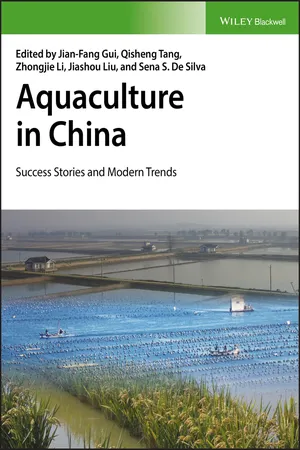
Aquaculture in China
Success Stories and Modern Trends
- English
- ePUB (mobile friendly)
- Available on iOS & Android
Aquaculture in China
Success Stories and Modern Trends
About this book
Fish have been a major component of our diet and it has been suggested that fish/seafood consumption contributed to the development of the human brain, and this together with the acquisition of bipedalism, perhaps made us what we are. In the modern context global fish consumption is increasing. However, unlike our other staples, until a few years back the greater proportion of our fish supplies were of a hunted origin. This scenario is changing and a greater proportion of fish we consume now is of farmed origin.
Aquaculture, the farming of waters, is thought to have originated in China, many millennia ago. Nevertheless, it transformed into a major food sector only since the second half of the last century, and continues to forge ahead, primarily in the developing world. China leads the global aquaculture production in volume, in the number of species that are farmed, and have contributed immensely to transforming the practices from an art to a science.
This book attempts to capture some of the key elements and practices that have contributed to the success of Chinese aquaculture. The book entails contributions from over 100 leading experts in China, and provides insights into some aquaculture practices that are little known to the rest of the world. This book will be essential reading for aquaculturists, practitioners, researchers and students, and planners and developers.Frequently asked questions
- Essential is ideal for learners and professionals who enjoy exploring a wide range of subjects. Access the Essential Library with 800,000+ trusted titles and best-sellers across business, personal growth, and the humanities. Includes unlimited reading time and Standard Read Aloud voice.
- Complete: Perfect for advanced learners and researchers needing full, unrestricted access. Unlock 1.4M+ books across hundreds of subjects, including academic and specialized titles. The Complete Plan also includes advanced features like Premium Read Aloud and Research Assistant.
Please note we cannot support devices running on iOS 13 and Android 7 or earlier. Learn more about using the app.
Information
Section 1
Notable Developments in Chinese Aquaculture in the Past Few Decades
Chapter 1.1
Contribution of Chinese Aquaculture to the Sector, Globally, and to Overall Food Security
1.1.1 Evolution of Chinese Aquaculture
Table of contents
- Cover
- Title page
- Copyright
- Editors
- Table of Contents
- List of Contributors
- Foreword
- Preface
- Acknowledgments
- Section 1: Notable Developments in Chinese Aquaculture in the Past Few Decades
- Section 2: Traditionally Farmed Species/Species Groups and Farming Practices
- Section 3: Emerging Cultured Species/Species Groups
- Section 4: Alien Species in Chinese Aquaculture
- Section 5: Developments in Feeds in Chinese Aquaculture
- Section 6: Genetic Breeding and Seed Industry
- Section 7: Environmental-Related Issues in Chinese Aquaculture
- Section 8: Development Strategies and Prospects
- Index
- End User License Agreement